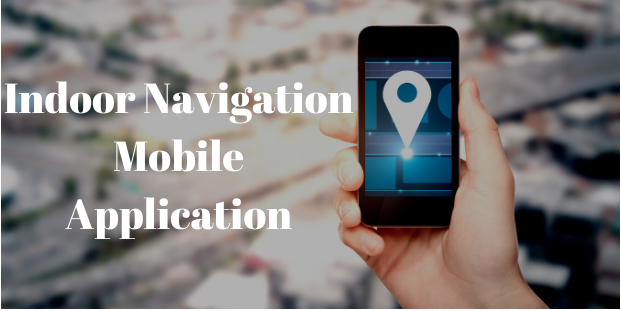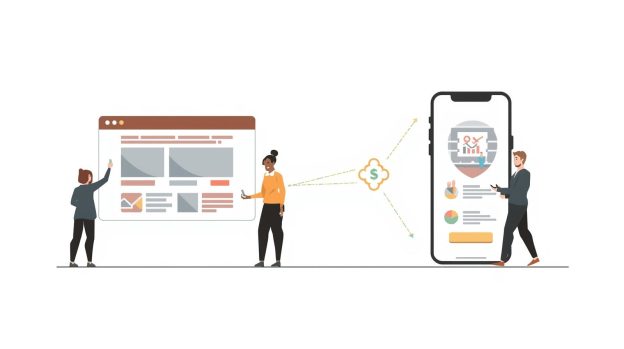How to Develop an Indoor Navigation Mobile Application?

Finding your way around any corner of the world has become extremely simple, thanks to GPS. Or has it? Suppose you make plans with your friends to meet up at a cafe inside a mall. You type in the location where you want to get to, you reach the mall, but as soon as you enter, you lose GPS reception, and now you are asking everyone around you about that particular cafe, but no one seems to know where it is hidden in a multi-storeyed building. Don’t worry. Everyone has been there.
This is where IPS (Indoor Positioning System) comes into play. IPS is simply an example of how fast technology is advancing. With so many large buildings, everyone could use an Indoor Positioning and Navigation app on their phone. Let us dive deep into the subject.
What is the Indoor Positioning System?
To put it in simple words, it is a GPS for indoor settings. It helps you navigate your way around large buildings, find people and objects via a mobile device, such as smartphones or tablets. However, this technology may seem like GPS, but it is much advanced and gaining momentum in hospitals, universities, airports, shopping malls, and other vast indoor places that cannot do without navigation or Location Based Services (LBS).
What information does this app show?
Talking about what this shows on the screen of the devices of the user, from the current location, all possible routes to the shortest path, it covers everything. To generate comprehensive maps, advanced technology like augmented reality and BLE Beacons are used, which makes the app ultra-modern. Navigation apps like these have three major functions:
–> Positioning: It simply means locating any sort of location anywhere in the building.
–> Navigation: Being the major purpose of the app, it helps in directing the user to their desired location through the shortest path possible.
–> Push Notifications: Alerts the user with relevant messages by sending push notifications.
How are IPS apps useful for business?
Since businesses such as warehouses, offices, etc. occupy large spaces, it can be often difficult for a new visitor, or even an old one to navigate their way around the building. An IPS makes that task simpler and is, therefore, beneficial to both visitors and facility owners. From a business point of view, this app can be put to a lot of use, and facility owners can have a lot of other advantages through this. To name a few of them:
–> Collect data on users such as their frequently visited places and time to better the business.
–> Generate automated notifications to the users about their wish listed products or discounts on searched stores by linking apps to their respective things.
How are IPS apps useful for visitors?
Every app is developed to meet the requirements of the users, and target audience. In the same way, an Indoor Positioning and Navigation mobile app are very practical and handy for the visitors. The app enables users to get to their desired location and offers a plethora of benefits.
–> Show a real-time map of the building
–> Easy search for destinations
–> Create and view all the possible routes
–> Generate the shortest path possible
–> Voice directions make the whole process of navigation hassle-free
–> Share their real-time location with someone else
How does the Indoor Navigation app work?
An indoor positioning and navigation app uses complex mathematical algorithms to calculate the indoor position of the device by tapping into its internal sensors and leveraging them. The data collected from the sensors are then combined in an ingenious way to compute the precise location without leaving any room for latency.
The chief purpose to develop this app is to offer the best experience to their user. To do so, indoor position technology depends on three elements.
–> Underlying dynamic positioning system platform
–> Beacons broadcasting signals received from the smartphone
–> Serving signals to the positioning system
For this app to work smoothly and to calculate an accurate location, it collects data from various sources. The input data include Wi-Fi access points and beacons that help in transmitting signals, working on a gyroscope, accelerometer for the sensors used in data collection. Then finally information about obstacles, walls, staircase, elevator, etc. that gives the facility map concluding that an indoor navigation system requires:
–> Map of the building/facility
–> A mobile device for the app
–> BLE beacons
–> BackEnd servers
Basic features of an Indoor Navigation App
Just like any other mobile app, there are some indispensable features for these types of the app too.
Positioning: It helps in determining the real-time location of the user by taking advantage of various positioning systems and algorithms.
Mapping: This shows the map of the building with all the possible routes. It also displays the number of people present at a location at a given time.
Administrative Capabilities: It helps the managers to maintain beacons to set up promotional campaigns for their business.
Navigation: This displays the shortest and fastest path available to the user.
Analytics: This is a significant feature for the business as it shows the number of people at a particular location during certain hours, the most searched and visited locations and many more.
Advanced features of an Indoor Navigation App
–> Social login/signup (via Facebook, Gmail, etc.)
–> Map visualization with 3D effects
–> Guidance through voice command
–> Find a person
–> Custom design
The technology required for an Indoor Navigation app
Wi-Fi Access Points: Although it covers more range area-wise, it doesn’t keep track of the location of the user. Instead, your phone does that which only results in more battery consumption.
BLE Beacons: With more battery life and higher accuracy range (2-3 meters), these signals are supported by both mobile operating systems. With BLE beacon navigation, any extra load on the user’s device is eradicated since the route is calculated on the server. However, users need to be within the range of at least three beacons for that to happen. This is known as the triangulation process.
Geofencing: This makes use of the device’s built-in navigational compass as well as a geomagnetic map of the place. However, the magnetic area needs to be steady for this process.
How much does it cost to build an Indoor Navigation app?
It is hard to place a finger on an exact price that will develop the app, but several factors help in deciding the cost for development:
Platform: Since the technology used for both Android and iOS differ from each other, the cost of development differs with the choice of platform as well.
App Design: How complex or simple you want the UX/UI design of your app affects the development cost as well.
The complexity of the app: The more complex the application is, the larger the size gets and the more price it takes to develop.
To give a rough amount, your app development will cost ranging from 10,000-50,000 USD, depending on the aforementioned factors. Talking about hardware, the average price of a three-piece BLE beacon kit cost around $20 to $60 whereas the price of geofencing will vary. There are some additional services which you have to pay for after the development is done, which are as follows:
–> Servers, since all the mapping information will be stored here.
–> Apps will also require updates and upgrades from time-to-time for them to function smoothly.
–> Some paid subscriptions for location engines as well as PaaS (Platform-as-a-Service).
Team structure for Indoor Navigation app development
Since the team is the most crucial aspect of app development, it is essential to hire skilled professionals. The personnel that you will require for your app development process is as well follows:
–> Project Manager
–> UX/UI Designer
–> Developer: Android, iOS, Backend
–> Quality Assurance Engineers
Conclusion
It is safe to say that this technology has several benefits to it, both for business and user ends. So, if you are planning to develop an Indoor Positioning and Navigation app, we suggest you plan each phase of the mobile app development. Also, make sure you hire a team of experts or a professional and trusted mobile app development company.




